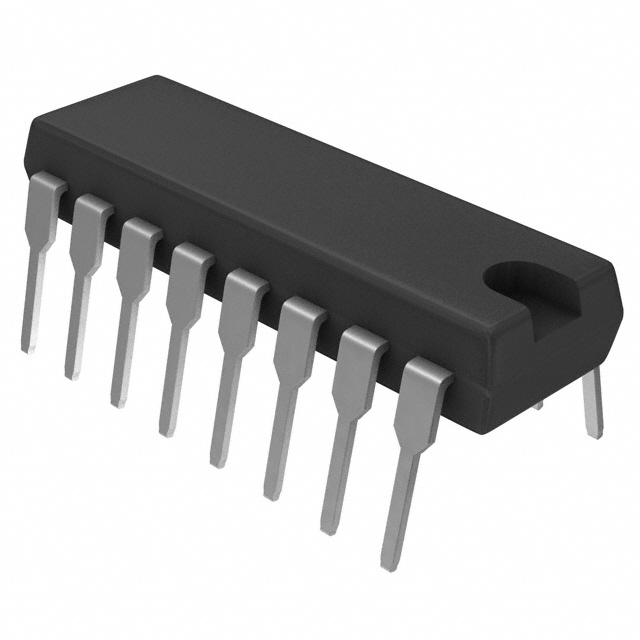AD7705BNZ
Product Overview
Category
AD7705BNZ belongs to the category of analog-to-digital converters (ADCs).
Use
The AD7705BNZ is used to convert analog signals into digital data. It is commonly employed in various applications where precise and accurate conversion of analog signals is required.
Characteristics
- High resolution: The AD7705BNZ offers a high-resolution conversion, allowing for accurate representation of analog signals.
- Low power consumption: This ADC is designed to operate with low power consumption, making it suitable for battery-powered devices.
- Wide input voltage range: The AD7705BNZ can handle a wide range of input voltages, enabling it to accommodate different signal levels.
- Serial interface: It features a serial interface that simplifies communication with microcontrollers or other digital devices.
- On-chip calibration: The ADC includes on-chip calibration mechanisms to ensure accurate and reliable conversions.
Package
The AD7705BNZ comes in a standard 24-pin plastic DIP (Dual Inline Package) format.
Essence
The essence of the AD7705BNZ lies in its ability to accurately convert analog signals into digital data, facilitating further processing and analysis.
Packaging/Quantity
The AD7705BNZ is typically packaged in reels or tubes, with a quantity of 25 units per package.
Specifications
- Resolution: 16 bits
- Input voltage range: ±Vref
- Conversion rate: Up to 50 kSPS (samples per second)
- Operating voltage: 2.7V to 5.25V
- Power consumption: 1.3 mW (typical)
- Temperature range: -40°C to +85°C
Detailed Pin Configuration
- VDD: Power supply voltage
- VSS: Ground reference
- REF IN(+): Positive reference voltage input
- REF IN(-): Negative reference voltage input
- AIN1(+) / AIN3(+): Positive analog input channel 1 / 3
- AIN1(-) / AIN3(-): Negative analog input channel 1 / 3
- AIN2(+) / AIN4(+): Positive analog input channel 2 / 4
- AIN2(-) / AIN4(-): Negative analog input channel 2 / 4
- SYNC: Synchronization input
- SCLK: Serial clock input
- DOUT: Data output
- DIN: Data input
- DRDY: Data ready output
- PD: Power-down mode control
- CS: Chip select input
- AVDD: Analog power supply voltage
- DVDD: Digital power supply voltage 18-21. NC: No connection
- AGND: Analog ground reference
- DGND: Digital ground reference
- REFIN: Reference voltage input
Functional Features
- High-resolution conversion: The AD7705BNZ offers 16-bit resolution, ensuring accurate representation of analog signals.
- Programmable gain amplifier: It includes a programmable gain amplifier that allows for amplification of weak signals or attenuation of strong signals.
- On-chip calibration: The ADC features on-chip calibration mechanisms to compensate for offset and gain errors, ensuring accurate conversions.
- Serial interface: The serial interface simplifies communication with microcontrollers or other digital devices, enabling easy integration into various systems.
- Low power consumption: The AD7705BNZ is designed to operate with low power consumption, making it suitable for power-sensitive applications.
Advantages and Disadvantages
Advantages
- High resolution enables accurate conversion of analog signals.
- Wide input voltage range accommodates different signal levels.
- Low power consumption makes it suitable for battery-powered devices.
- On-chip calibration ensures accurate and reliable conversions.
- Serial interface simplifies communication with digital devices.
Disadvantages
- Limited number of analog input channels (4 channels).
- Requires external reference voltage for operation.
Working Principles
The AD7705BNZ operates based on the principle of successive approximation. It samples the analog input voltage, converts it into a digital representation using an internal ADC, and outputs the result through the serial interface. The on-chip calibration mechanisms compensate for offset and gain errors, ensuring accurate conversion.
Detailed Application Field Plans
The AD7705BNZ finds applications in various fields, including: 1. Industrial automation: Used for precise measurement and control of analog signals in industrial processes. 2. Medical devices: Employed in medical equipment for accurate data acquisition from sensors and transducers. 3. Instrumentation: Integrated into test and measurement instruments to convert analog signals into digital data for analysis. 4. Energy management: Utilized in energy monitoring systems to measure and analyze power consumption. 5. Automotive electronics: Incorporated in automotive systems for
Lista 10 Vanliga frågor och svar relaterade till tillämpningen av AD7705BNZ i tekniska lösningar
Sure! Here are 10 common questions and answers related to the application of AD7705BNZ:
Q: What is AD7705BNZ? A: AD7705BNZ is a 16-bit sigma-delta analog-to-digital converter (ADC) designed for precision measurement applications.
Q: What is the operating voltage range of AD7705BNZ? A: The operating voltage range of AD7705BNZ is typically between 2.7V and 5.25V.
Q: What is the maximum sampling rate of AD7705BNZ? A: The maximum sampling rate of AD7705BNZ is 20 samples per second (SPS).
Q: Can AD7705BNZ be used for both single-ended and differential measurements? A: Yes, AD7705BNZ supports both single-ended and differential measurements.
Q: What is the resolution of AD7705BNZ? A: AD7705BNZ has a resolution of 16 bits, providing high precision in measurement applications.
Q: Does AD7705BNZ have an on-chip programmable gain amplifier (PGA)? A: Yes, AD7705BNZ features an on-chip PGA with programmable gain options of 1, 2, 4, 8, 16, 32, 64, and 128.
Q: Can AD7705BNZ interface directly with microcontrollers or microprocessors? A: Yes, AD7705BNZ can interface directly with microcontrollers or microprocessors through a serial peripheral interface (SPI).
Q: Is AD7705BNZ suitable for low-power applications? A: Yes, AD7705BNZ is designed for low-power applications and features a power-down mode to conserve energy.
Q: What is the input voltage range of AD7705BNZ? A: The input voltage range of AD7705BNZ is typically ±Vref, where Vref is the reference voltage provided externally.
Q: Can AD7705BNZ be used in temperature measurement applications? A: Yes, AD7705BNZ can be used in temperature measurement applications by interfacing with appropriate temperature sensors.
Please note that these answers are general and may vary depending on specific application requirements and configurations.


